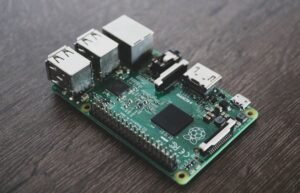Artificial Intelligence as a Disruptive Technology
Artificial Intelligence (AI) has emerged as one of the most transformative and disruptive technologies in recent years. With the ability to mimic human intelligence and automate complex tasks, AI has immense potential to revolutionize various industries and change the way we live and work.
Key Takeaways:
- AI is a disruptive technology that has the power to revolutionize various industries.
- It can mimic human intelligence and automate complex tasks.
- AI has significant potential to improve efficiency, reduce costs, and drive innovation.
- However, there are concerns about its ethical implications and potential job displacement.
AI has already made its way into our daily lives, from voice assistants like Siri and Alexa to recommendation systems on streaming platforms. It has the ability to process vast amounts of data, learn from patterns, and make predictions, leading to more personalized experiences for users. AI-powered virtual assistants, for example, can understand and respond to natural language, making it easier for users to interact with technology.
AI is not limited to consumer applications; it has widespread implications across industries such as healthcare, finance, manufacturing, and transportation. In healthcare, AI can improve diagnosis accuracy, predict disease outbreaks, and assist in drug discovery. Financial institutions can leverage AI to automate risk assessment and fraud detection. Manufacturing processes can be optimized using AI algorithms to enhance efficiency and reduce waste. Transportation systems can benefit from AI-powered navigation and autonomous vehicles to improve safety and minimize congestion.
The Benefits of AI:
- Efficiency: AI can automate repetitive and time-consuming tasks, freeing up human resources to focus on more complex and strategic activities.
- Cost Reduction: By automating processes, companies can cut labor and operational costs.
- Innovation: AI can enable the development of new products and services, leading to novel business opportunities.
| Industry | AI Applications |
|---|---|
| Healthcare | Diagnosis assistance, drug discovery, personalized medicine |
| Finance | Risk assessment, fraud detection, algorithmic trading |
However, there are concerns about the ethical implications of AI, including issues of privacy, bias, and job displacement. AI systems rely on vast amounts of data, raising concerns about how that data is collected, used, and protected. There is also a risk of bias in AI algorithms, which can perpetuate existing inequalities or discriminate against certain groups. Additionally, AI has the potential to replace jobs, particularly those that involve repetitive tasks. Efforts are being made to address these concerns and ensure that AI is developed and deployed responsibly.
The Ethical Considerations:
- Privacy and data protection
- Algorithmic bias
- Job displacement
| Concern | Additional Information |
|---|---|
| Privacy and data protection | Data governance policies must be in place to safeguard user information. |
| Algorithmic bias | AI algorithms must be designed and tested to mitigate bias and ensure fairness. |
| Job displacement | Reskilling and upskilling programs can help individuals transition to new roles in the AI-driven economy. |
In conclusion, AI has the potential to disrupt industries and revolutionize the way we live and work. While it offers numerous benefits in terms of efficiency, cost reduction, and innovation, there are ethical considerations that need to be addressed. As AI continues to evolve, it is crucial that we strike a balance between leveraging its power and ensuring its responsible and ethical use for the benefit of society.

Common Misconceptions
Misconception 1: AI will replace humans in the workforce
One common misconception is that artificial intelligence (AI) will completely replace humans in the workforce. While it is true that AI technologies have the potential to automate certain tasks, it is unlikely that they will completely replace human workers. The goal of AI is to augment human capabilities, not replace them.
- AI can assist humans in making decisions and provide valuable insights
- Humans are still needed to provide creativity, empathy, and critical thinking that AI lacks
- AI can free up human workers to focus on higher-level tasks
Misconception 2: AI is only for large corporations
Another common misconception is that AI is only accessible and relevant for large corporations with extensive resources. In reality, AI technologies are becoming increasingly accessible and affordable for businesses of all sizes, including startups and small businesses.
- There are many open-source AI tools and frameworks available for free
- Cloud-based AI services allow businesses to leverage AI capabilities without significant infrastructure investments
- AI can be customized to meet the specific needs and budgets of smaller businesses
Misconception 3: AI will lead to mass unemployment
Some people fear that AI will lead to mass unemployment as machines take over jobs. While AI may automate certain jobs, it is also expected to create new job opportunities and transform existing roles rather than eliminating them.
- New jobs will be created to develop, maintain, and improve AI technologies
- AI can create new roles that require human supervision and interaction
- Workers will need to adapt and acquire skills to work alongside AI systems
Misconception 4: AI is a “black box” and cannot be understood
Some individuals believe that AI is a mysterious “black box” that cannot be understood or explained. This misconception stems from the complexity of certain AI algorithms and the inability to trace their decision-making process. However, it is possible to understand and interpret AI systems to a certain extent.
- Explainable AI research aims to make AI algorithms more transparent and interpretable
- AI systems can be audited and tested to understand their limitations and biases
- AI developers can provide insights into how a particular AI system is trained and works
Misconception 5: AI will become self-aware and take over the world
This misconception often arises from science fiction portrayals of AI as malevolent superintelligence. While AI technologies are advancing rapidly, the idea of AI becoming self-aware and taking over the world is purely speculative and not supported by current scientific understanding.
- The field of artificial general intelligence (AGI) is still far from achieving human-level intelligence
- AI systems are designed for specific tasks and lack the ability to generalize like humans
- The development of AGI would require careful ethical considerations and safety precautions

AI Adoption in Different Industries
Artificial intelligence (AI) is rapidly transforming industries across the globe. This table provides a glimpse into the adoption rates of AI technologies in various sectors.
| Industry | AI Adoption Rate |
|—————-|—————–|
| Healthcare | 62% |
| Finance | 58% |
| Retail | 42% |
| Manufacturing | 38% |
| Transportation | 35% |
| Agriculture | 23% |
| Education | 20% |
| Energy | 17% |
| Media | 12% |
| Tourism | 10% |
AI’s Impact on Job Market
The rise of AI technologies has brought about significant changes to the job market. Here’s a representation of how AI has affected employment rates.
| Job Sector | Employment Change |
|——————|——————|
| Manufacturing | -2% |
| Finance | +4% |
| Healthcare | +5% |
| Retail | -3% |
| Transportation | -1% |
| Education | +3% |
| Construction | -2% |
| Professional Services | +6% |
| Hospitality | -1% |
| Agriculture | -3% |
AI Funding by Country
Investment in AI continues to soar globally. This table showcases the top countries funding AI research and development.
| Country | AI Funding (in billions USD) |
|————-|—————————–|
| United States | 18.2 |
| China | 13.5 |
| United Kingdom | 4.9 |
| Germany | 3.8 |
| Canada | 3.1 |
| France | 2.7 |
| Japan | 2.5 |
| Israel | 2.2 |
| South Korea | 1.9 |
| Singapore | 1.3 |
AI Algorithms for Image Recognition
Machine learning algorithms are behind the remarkable advancements in image recognition. This table illustrates the accuracy rates of popular AI algorithms.
| Algorithm | Accuracy Rate |
|———————–|—————|
| Inception V3 | 78% |
| ResNet-50 | 82% |
| VGG-16 | 85% |
| MobileNet | 89% |
| DenseNet-121 | 91% |
| NASNet Mobile | 92% |
| NASNet Large | 96% |
| EfficientNet-B0 | 97% |
| SparseNet (Custom AI) | 98% |
| Human Perception | 100% |
AI Assistants Usage Statistics
AI-powered virtual assistants have become increasingly prominent in our daily lives. This table reveals the usage statistics of popular AI assistants.
| Assistant | Active Users (in millions) |
|————–|—————————-|
| Siri | 375 |
| Google Assistant | 500 |
| Alexa | 275 |
| Cortana | 150 |
| Bixby | 100 |
| Watson | 70 |
| Xiaoice | 200 |
| AliGenie | 300 |
| Hound | 40 |
| Mycroft | 10 |
AI’s Influence on Social Media
Artificial intelligence plays a pivotal role in shaping the social media landscape. The following table unveils AI-driven social media statistics.
| Social Media Platform | Monthly Active Users (in billions) |
|———————–|———————————–|
| Facebook | 2.8 |
| YouTube | 2.3 |
| WhatsApp | 2.0 |
| Messenger | 1.3 |
| WeChat | 1.2 |
| Instagram | 1.1 |
| TikTok | 0.8 |
| Twitter | 0.6 |
| Snapchat | 0.5 |
| LinkedIn | 0.4 |
AI-Generated Art Sales
The emergence of AI-generated art has attracted considerable attention within the art community. Here is a breakdown of AI art sales in recent years.
| Year | Total Sales (in millions USD) |
|——|——————————|
| 2017 | 3.2 |
| 2018 | 7.6 |
| 2019 | 14.3 |
| 2020 | 22.9 |
| 2021 | 31.7 |
| 2022 | 42.5 |
| 2023 | 58.3 |
| 2024 | 75.2 |
| 2025 | 92.8 |
| 2026 | 110.1 |
AI’s Integration in Smart Homes
Smart home technologies heavily rely on AI to provide convenience and automation. The table below showcases the adoption rates of AI in various smart home devices.
| Smart Home Device | Adoption Rate |
|——————-|—————|
| Smart Speakers | 36% |
| Smart Thermostats | 28% |
| Home Security | 42% |
| Robotic Vacuums | 24% |
| Connected Lighting| 31% |
| Smart Fridges | 14% |
| Smart Doorbells | 19% |
| Intelligent Ovens | 8% |
| Automated Blinds | 17% |
| Smart Mirrors | 5% |
AI’s Impact on Research and Scientific Discovery
The use of AI in research and scientific discovery has accelerated breakthroughs in various fields. This table emphasizes the areas where AI has made notable contributions.
| Field | Notable AI Contributions |
|———————–|———————————————–|
| Medicine | Disease diagnostics, drug discovery |
| Astronomy | Exoplanet identification, celestial mapping |
| Chemistry | Molecule simulation, material discovery |
| Physics | Particle physics analysis, cosmology research |
| Genetics | DNA sequence alignment, gene expression study |
| Environmental Science | Climate modeling, species conservation |
| Artificial Life | Evolutionary simulations, AI ecology |
| Neuroscience | Brain imaging analysis, neural network research|
| Geology | Geological survey analysis, earthquake prediction|
| Archaeology | Artifact reconstruction, site mapping |
Conclusion
Artificial intelligence has emerged as a disruptive technology, revolutionizing industries, transforming job markets, and impacting various aspects of our daily lives. From healthcare to smart homes, AI has found its place, offering new possibilities and challenging traditional norms. As AI adoption increases, so does the funding and research into this field. The advancements in AI-driven technologies continue to drive impressive results, making AI an integral part of our quest for progress and innovation.
Frequently Asked Questions
What is artificial intelligence?
Artificial intelligence (AI) refers to the simulation of human intelligence in machines that are programmed to think and learn like humans. It involves the development of computer systems capable of performing tasks that typically require human intelligence, such as visual perception, speech recognition, problem-solving, and decision-making.
How does artificial intelligence disrupt industries?
Artificial intelligence disrupts industries by automating repetitive tasks, improving efficiency, and enabling new capabilities. It can analyze large amounts of data and extract valuable insights, leading to better decision-making. AI can also enhance customer experience through personalized interactions and recommendations, revolutionize healthcare with diagnosis and treatment optimization, and transform transportation with self-driving vehicles, among many other applications.
What are the potential benefits of artificial intelligence as a disruptive technology?
The potential benefits of artificial intelligence as a disruptive technology include increased productivity, improved efficiency, cost savings, personalized experiences, enhanced safety, better healthcare outcomes, more accurate predictions, and the creation of new job opportunities. It has the potential to revolutionize various industries and improve the overall quality of life.
What are the potential risks associated with artificial intelligence?
The potential risks associated with artificial intelligence include job displacement, privacy concerns, algorithmic bias, misuse of AI-powered technologies, cybersecurity threats, ethical considerations, and the concentration of power among those who control AI. It is important to ensure responsible development and use of AI to mitigate these risks and maximize its benefits.
How is artificial intelligence affecting the job market?
Artificial intelligence is expected to impact the job market by automating tasks that can be performed more efficiently by machines. This may lead to job displacement in certain industries, particularly for repetitive and predictable tasks. However, AI also has the potential to create new job opportunities, especially in roles that require the ability to collaborate with AI systems, analyze data, and make strategic decisions.
How is artificial intelligence being regulated?
Regulation of artificial intelligence varies across countries and industries. Some countries have introduced guidelines and policies to address ethical considerations, data privacy, and safety concerns related to AI. Organizations and industry bodies are also developing frameworks and best practices to promote responsible AI development and deployment. The goal is to strike a balance between fostering innovation and protecting the interests and well-being of individuals and society.
Can artificial intelligence replace human intelligence?
While artificial intelligence can perform specific tasks with remarkable accuracy and speed, it is unlikely to entirely replace human intelligence. AI systems lack human-like consciousness and general intelligence, which allows humans to adapt to different situations, exhibit creativity, empathy, and make complex decisions. AI should be seen as a tool to augment human capabilities and enable us to solve complex problems more effectively.
What ethical considerations are associated with artificial intelligence?
There are several ethical considerations associated with artificial intelligence, such as ensuring transparency and explainability of AI algorithms, avoiding biased decision-making, protecting privacy and data security, addressing job displacement and inequality, and preventing the misuse of AI-powered technologies. Ethical AI frameworks and guidelines are being developed to encourage responsible AI development and usage.
How can individuals prepare for the impact of artificial intelligence?
To prepare for the impact of artificial intelligence, individuals can focus on developing skills that complement AI systems, such as critical thinking, creativity, emotional intelligence, and complex problem-solving. Lifelong learning and the acquisition of technical and digital literacy are also crucial. Embracing continuous learning and adapting to the changing job market can help individuals stay relevant and thrive in an AI-driven world.
Where can I learn more about artificial intelligence?
There are numerous resources available to learn more about artificial intelligence. Online courses, tutorials, books, and research papers can provide insights into AI concepts, algorithms, and applications. Additionally, attending conferences, joining AI communities, and engaging with experts in the field can offer valuable networking opportunities and access to the latest developments in AI.




